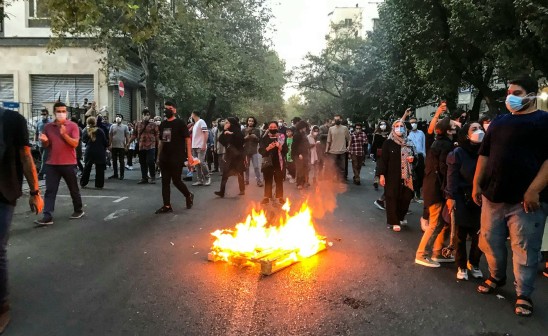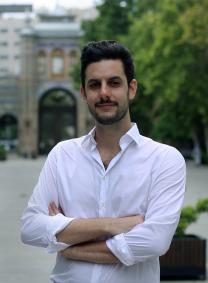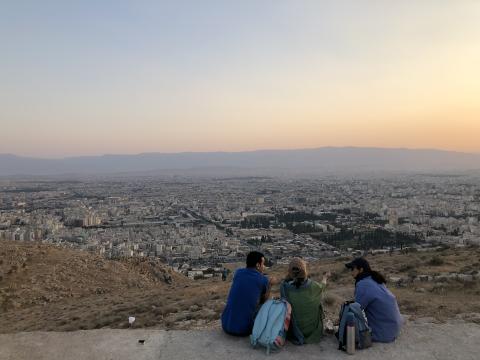Ethnography and Journalism: Humanizing Revolution Through Interviews

PhD Student Alex Shams combines his journalism background and ethnographic research skills to offer a view of what’s happening on the ground in Iran during the protests
by Aubrey Christofersen
As the world saw through extensive media coverage, the country of Iran erupted into a new wave of protests in the wake of the September 16, 2022 killing of 22-year-old Mahsa Jina Amini. Citizens took to the streets demanding an end to the mandatory hijab law that had led to Amini’s arrest, an expansion of their rights, and even full-scale regime change.
Anthropology PhD student Alex Shams decided to use his unique set of skills and experiences to shed light on the situation in Iran, writing pieces in the LA Times and New York Magazine’s Intelligencer section, bringing the perspective of Iranians on the ground to those outside of the country.
“There’s a tendency to look at these movements from a perspective of what they’re doing, what they’re achieving, and what happens, whereas the space of the protest itself is so central to people’s experience and how they understand what’s going on. Yet that’s what’s inaccessible from outside.”
Shams set out to interview Iranians from across the country, gaining an insider’s perspective of what it’s like to be on the ground during the protests, including the motivations and fears of everyday people.
“None of the interviewees were people I was working with for my fieldwork, but they were based on connections I made with activists and other people I met while I was in Iran,” says Shams, “They were only possible because of my years researching there.”
Shams’ fieldwork, based in Tehran from 2018-21, focused on the relationship between religion and politics, particularly around religious sites like shrines and the dynamics within them.
“One focus of my research was how government attempts to monopolize religion in Iran really changed religion itself in the country,” he says. “Certain interpretations and leaders were being favored over others, and at the same time religious spaces I was looking at were becoming linked to state power and economic projects, while others were being excluded or repressed.”
The ethnographic work he was doing in Iran was not the first fieldwork Shams had done, however. Because part of his own family is Iranian, he always had an interest in Iran and the Middle East more generally. Soon after finishing his MA degree, Shams applied to work at a news desk in the West Bank, Palestine. “One thing I really appreciated about journalism was the opportunity to be on the ground and talk to people, and explore the background behind the stories we were covering,” says Shams. But he soon realized a problem: he was becoming more interested in the background complexities of the conflicts he was reporting on, more so than the individual reports.
“I would have a few weeks to work on a story. I could interview a few people and I felt like just as I was coming to understand the bigger picture, I had to write, publish, and move on to something else.”
Shams’ eye quickly turned to academia as a way to take a deeper look at the issues he was interested in. “I was interested in the Arab world and the region around it, and specifically in understanding Iran since I have family there and grew up visiting,” he says. “I saw that I could apply some of the tools that I had developed in journalism through an anthropology program to explore these bigger questions.”
In his PhD program, Shams found the capacity to investigate these issues further: “Anthropology gave the space to not only do much more research and understand these much wider contexts, but also to explore things in a much deeper and more profound way.”
In particular, he found himself able to interview more people and dive into more angles than he ever could as a journalist, something that he says offered the ability to “piece together many more parts of much more complex stories.”
Shams’ fieldwork also gave him the resources he’s using today to write about the protests in Iran. “Basing yourself in a place for so long means that you meet so many different kinds of people and build so many different kinds of connections,” he says. Because of the intense repression occurring in Iran, this network of connections is especially important to Alex’s project. “In Iran, there is an atmosphere of mistrust–where people are afraid of each other,” he says, “So trust is crucial while doing fieldwork, and also while writing these articles.”
Conducting interviews through what he calls “self-destructing WhatsApp chats,” Shams was able to gain an inside view of how people were conceptualizing the protests, an inside view that is important to understand. He highlights the importance of understanding that there are many different people on the streets of Iran protesting.
“What I see as important for people outside Iran to know when it comes to the protest is that the demands of the people are an end to the dictatorship. They’re not trying to destroy religion, which is how the government frames it to discredit them, but instead trying to build a democratic society in which there’s room for a diversity of opinions.”
Shams’ background in journalism, anthropology, and a personal connection to Iran gives him a unique perspective and ability to cover the protests across the country, but also an emphasis on humanizing the uprising.
“We’re watching the paradigm shift in real time in Iran,” he says, “and the important thing about moments like this is recognizing the need to be humble as academics and as journalists, and the need to understand that we’re watching people risk their lives for what they believe in.”
 THE UNIVERSITY OF CHICAGO
THE UNIVERSITY OF CHICAGO



